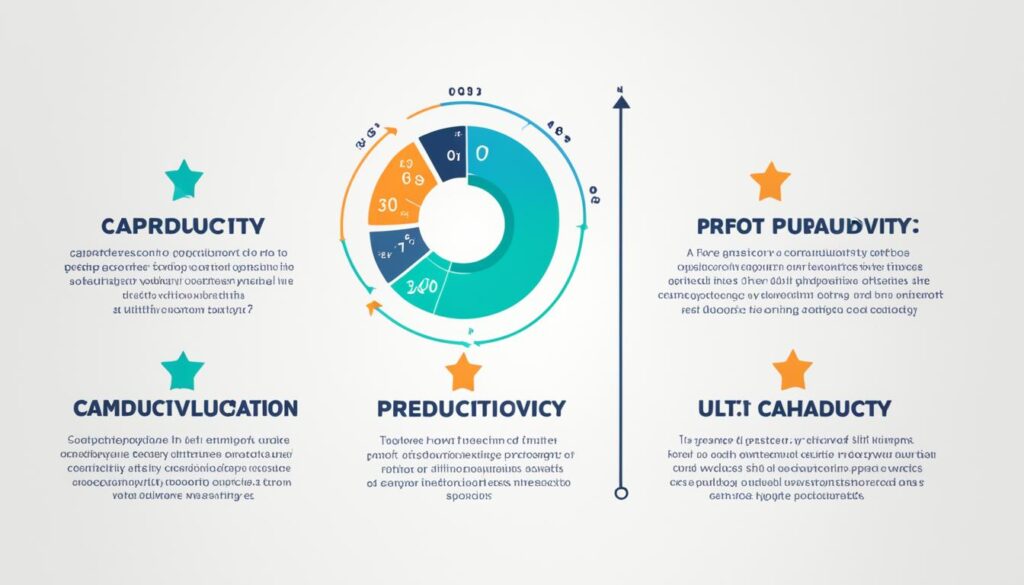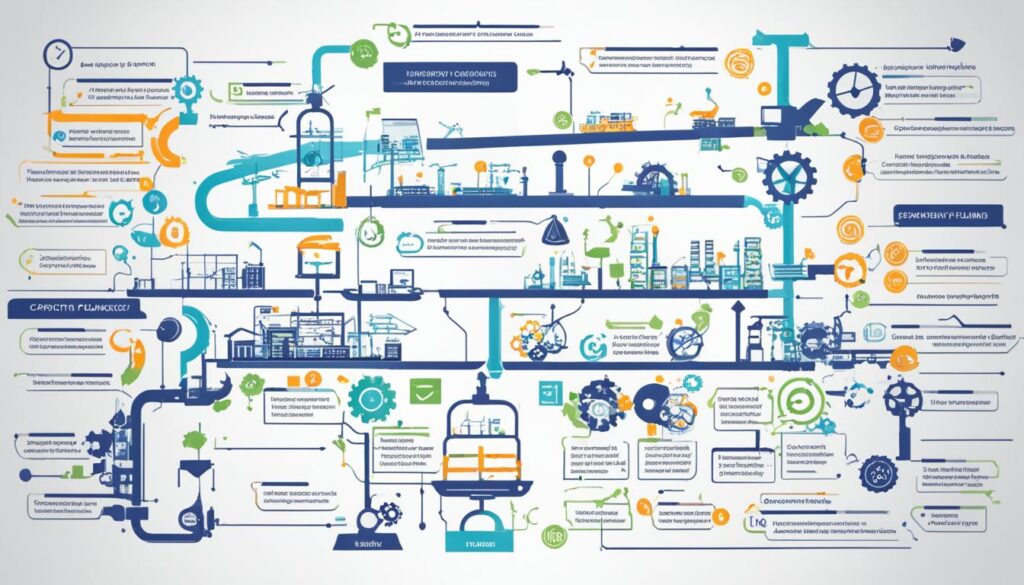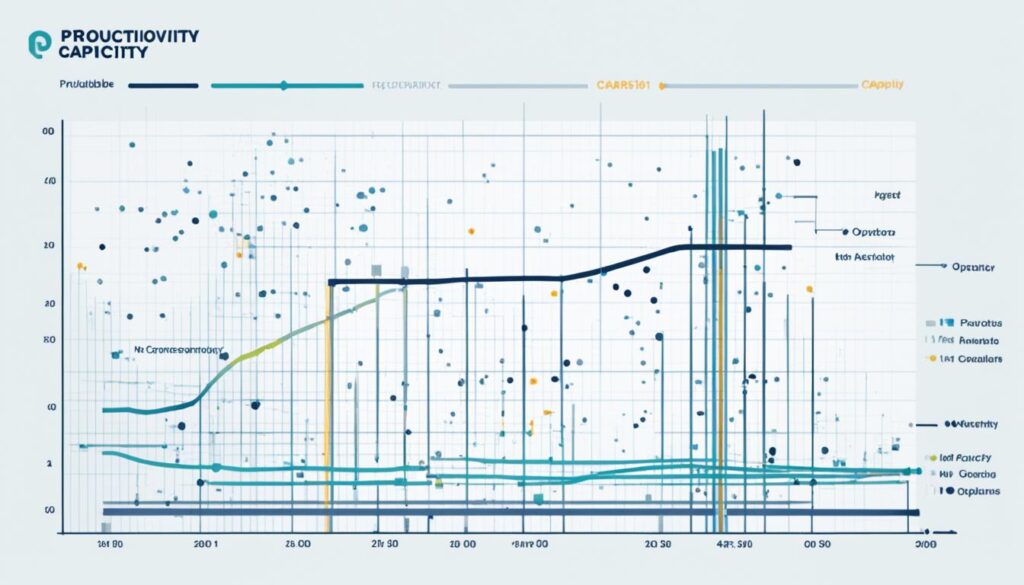Unlock Your Potential with the Productivity Formula

Are you tired of feeling overwhelmed by your to-do list? Do you wish you could achieve more in less time? It’s time to discover the power of the productivity formula and take control of your efficiency. Whether you’re a student, a professional, or an entrepreneur, implementing the right mindset and strategies can unlock your potential and maximize your productivity.
So, how can you improve your efficiency and streamline your workflow? How can you effectively manage your time and accomplish more in a day? The productivity formula holds the key to these questions and more. By understanding and applying this proven methodology, you can transform your approach to work and achieve greater success.
In this article, we will delve into the productivity formula, explore its components, and provide practical tips for its application. Get ready to unlock your potential and take your productivity to new heights.
Key Takeaways:
- The productivity formula is a powerful tool to enhance workflow and achieve more in less time.
- Setting clear goals that are specific, measurable, achievable, relevant, and time-bound is crucial for focus and direction.
- The capacity equation plays a significant role in optimizing productivity and workflow.
- Calculating capacity utilization allows for the assessment and improvement of efficiency.
- Applying the capacity equation has practical applications in various industries to streamline operations and achieve goals.
Understanding the Components of the Capacity Equation
The capacity equation is a fundamental concept in optimizing productivity and workflow. It involves assessing the maximum potential of a system to produce or deliver, taking into account factors such as physical resources, expertise, and market demand. By understanding the components of the capacity equation and effectively balancing them, you can maximize your efficiency and output.
One crucial component of the capacity equation is utilization. Optimizing the use of resources ensures that productivity is at its peak. By carefully managing and allocating resources, you can eliminate inefficiencies and streamline your workflow.

Components of the Capacity Equation
Let’s take a closer look at the key components that make up the capacity equation:
| Component | Description |
|---|---|
| Physical Resources | The tangible assets, such as equipment, technology, and facilities, needed to perform tasks and deliver products or services. |
| Expertise | The knowledge, skills, and abilities of individuals or teams involved in the production process, crucial for efficient operations. |
| Market Demand | The level of demand for your products or services in the market, indicating the quantity that customers are willing to purchase. |
Effectively balancing these components ensures that your productivity remains optimized and aligned with market trends and customer expectations. By assessing and understanding the capacity equation, you can make informed decisions regarding resource allocation and workflow management.
Calculating Capacity Utilization with the Formula
Capacity utilization is a critical metric for evaluating and enhancing productivity. By analyzing how effectively resources are utilized, individuals and businesses can identify areas for improvement and maximize efficiency. The capacity utilization formula calculates the percentage of potential output that is being achieved based on actual output.
To calculate capacity utilization, use the following formula:
Capacity Utilization = (Actual Output ÷ Potential Output) x 100%
By dividing the actual output by the potential output and multiplying it by 100, you can determine the capacity utilization percentage. A higher percentage indicates that resources are being utilized efficiently, ensuring optimal productivity. On the other hand, a lower percentage may indicate inefficiencies or underutilized resources.
Monitoring and analyzing capacity utilization over time is crucial for optimizing resource allocation and improving overall productivity. Regularly assessing and adjusting capacity utilization allows for the identification of bottlenecks, waste reduction, and strategic decision-making.

Applying the Capacity Equation in Various Industries
The capacity equation is a powerful tool that can be applied in different industries to optimize operations, improve efficiency, and achieve business goals. Let’s explore how the capacity equation can be utilized in manufacturing, service industries, and project management.
Capacity Planning in Manufacturing
In manufacturing, capacity planning plays a crucial role in optimizing production processes and ensuring that supply meets demand. By using the capacity equation, businesses can effectively allocate resources, manage inventory levels, and prevent shortages or excesses. Capacity planning allows manufacturers to streamline their operations, meet customer demands, and maintain a competitive edge in the market.
Optimizing Resource Allocation in Service Industries
Service industries, such as marketing agencies, can benefit greatly from implementing the capacity equation. By understanding the demand for their services and the resources available, businesses can allocate their resources effectively, ensuring that client needs are met efficiently. This helps in providing high-quality services, improving customer satisfaction, and maximizing profitability.
Efficient Resource Management in Project Management
Project management heavily relies on capacity planning to prevent resource shortages and delays. By leveraging the capacity equation, project managers can assess the resources required for each project and allocate them accordingly. This ensures that projects are completed on time, within budget, and with optimal resource utilization. Effective capacity planning in project management leads to successful project outcomes and satisfied stakeholders.
Implementing the capacity equation in manufacturing, service industries, and project management allows businesses to streamline their operations, improve efficiency, and achieve their goals. By optimizing resource allocation, managing capacity, and preventing bottlenecks, organizations can maximize their productivity and deliver exceptional results.

Optimizing Operations with the Capacity Equation
To maximize productivity and efficiency, operations managers must harness the power of the capacity equation. This equation is the key to optimizing production processes, resource allocation, and demand forecasting, allowing businesses to thrive in a competitive market.
Understanding the capacity equation:
The capacity equation takes into account various factors, such as available resources, expert knowledge, and market demand. By carefully balancing these components, operations managers can fine-tune processes, eliminate waste and inefficiencies, and ensure optimal output. Let’s take a closer look at how each aspect contributes to operational success:
- Resource allocation: By understanding resource availability and demand, operations managers can allocate resources effectively, minimizing bottlenecks and ensuring a smooth workflow.
- Process optimization: Analyzing and optimizing production processes helps eliminate unnecessary steps, reduce errors, and increase overall efficiency. This leads to improved productivity and output.
- Demand forecasting: Accurate demand forecasting enables operations managers to align production levels with customer needs, preventing overproduction or underutilization of resources.
Creating an organized work environment:
Productivity thrives in an organized work environment. By reducing distractions and creating a focused atmosphere, individuals can better concentrate on their tasks and deliver optimal results. Operations managers can promote productivity by implementing the following strategies:
- Time-boxing tasks: Setting specific timeframes for completing tasks helps individuals stay on track and avoid unnecessary delays. This time management technique ensures that all tasks receive adequate attention and are completed in a timely manner.
- Prioritizing with the traffic light system: Using the traffic light system, where tasks are categorized as red (urgent), yellow (important), or green (not time-sensitive), operations managers can prioritize tasks effectively, ensuring that critical tasks receive appropriate attention.

Continual skill development and motivation:
Investing in ongoing skill development and motivation triggers is crucial for sustaining high levels of productivity. By providing training opportunities, promoting a growth mindset, and recognizing achievements, operations managers can create a motivated workforce that consistently performs at its best.
| Benefits of Optimizing Operations with the Capacity Equation | Challenges |
|---|---|
| Enhanced productivity and output | Identifying and resolving bottlenecks |
| Improved resource allocation | Adapting to changing market demands |
| Efficient production processes | Ensuring workforce competence |
Setting Smart Goals for Productivity
Setting smart goals is a fundamental aspect of increasing productivity. Smart goals are specific, measurable, achievable, relevant, and time-bound. By setting highly effective smart goals and breaking them down into weekly, monthly, and daily targets, you can stay focused and accountable to your objectives.
An organized work environment is essential for productivity as it reduces distractions and promotes efficiency. Time-boxing tasks and prioritizing them using the traffic light system will keep you on track and help you avoid last-minute rushes.
To further enhance your productivity, create task lists and utilize the 80/20 rule. Task lists allow you to visualize your priorities and ensure that you focus on the most important tasks first. The 80/20 rule, also known as the Pareto Principle, suggests that 80% of your results come from 20% of your efforts. By identifying and prioritizing the tasks that yield the most significant results, you can maximize your productivity and make the most of your time.
Remember, productivity is not just about working harder; it’s about working smarter. By setting smart goals, maintaining an organized workspace, time-boxing tasks, and utilizing task lists, you can optimize your productivity and accomplish more in less time.
How to Set Smart Goals:
- Specific: Clearly define what you want to achieve. Be specific about the outcome you desire.
- Measurable: Set criteria to measure your progress and determine when the goal is achieved.
- Achievable: Ensure that the goal is within your reach and can be realistically attained.
- Relevant: Align your goals with your overall objectives and ensure they contribute to your long-term success.
- Time-bound: Set a deadline for your goal to create a sense of urgency and keep yourself accountable.
The Traffic Light System:
| Color | Meaning |
|---|---|
| Green | Tasks that must be done today or within the next 24 hours. |
| Yellow | Tasks that are important but can be done within the next few days. |
| Red | Tasks that are not urgent or can be delegated or eliminated. |
Implementing these strategies will help you stay focused, prioritize effectively, and achieve your goals efficiently. By setting smart goals, utilizing task lists, and following the traffic light system, you can increase your productivity and make significant progress towards your objectives.
Conclusion
By implementing the productivity formula and applying the strategies discussed in this article, you can unlock your potential and achieve greater productivity. Defining your purpose gives you a clear direction, while setting clear goals ensures focus and accountability.
Understanding the capacity equation and optimizing operations are vital in maximizing productivity. By balancing resources effectively and eliminating inefficiencies, you can make the most out of your capabilities. Additionally, creating an organized work environment minimizes distractions and promotes efficiency.
To further enhance your productivity, try time-boxing tasks and utilizing the traffic light system to prioritize your workload. Setting smart goals and utilizing task lists will help you stay on track and ensure that the most important tasks are accomplished.
With the right mindset and the productivity formula as your guide, you can elevate your output, achieve more, and ultimately lead a more fulfilling and successful life. Maximize your productivity and seize every opportunity that comes your way.






